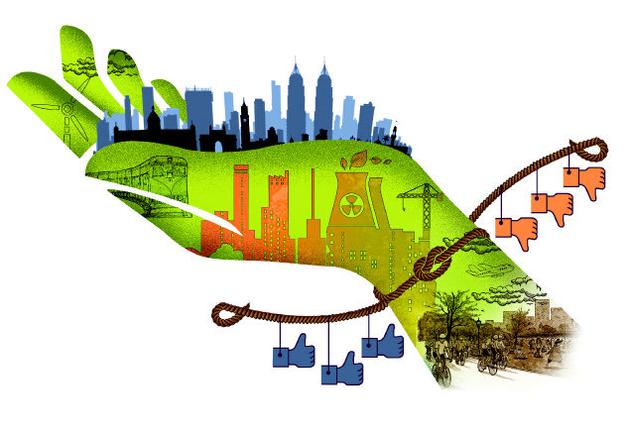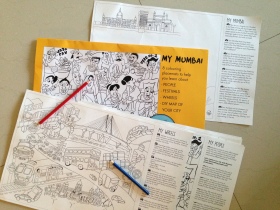Determined to showcase the city for children, two Mumbaikars decide to trace its history and lore in a fun book packed with trivia
Did you know that Leonardo da Vinci’s journal, Manuscript F, has “a mysterious note scribbled in it mentioning a map of Elephanta” or that Mumbai is home to two types of crows, the jungle and the common crow; or that almost 400km of Mumbai’s roads are dug up annually? If you’re looking for a book for children that introduces them to the maximum city, then Totally Mumbai: A City in a Book (Blue Spectacles) may just be right up your galli.
Written by Pereena Lamba and Miel Sahgal, the book traces the city’s history, acquaints children to its landmarks, and shares trivia and lore about Mumbai. And it’s packed with photographs, puns, and lots of information. Sahgal, a director at the Sanctuary Nature Foundation, said that Totally Mumbai was born out of a need to share “the city as a whole, from nature to culture, history to arts” with their children. For Lamba, who has worked in advertisting and is a writer, Mumbai is a city full of her best memories. “It shapes my opinions and view of the world,” she said. Over email, the writers talk about their venture into publishing for children.
Packing Mumbai into 85 pages – how difficult was it?
Pereena Lamba: It was an incredibly hard task to sift through the collection of stories that we discovered. We had debates, discussions and some heated arguments on what to include. In the end, I think we chose the facts and stories that would grab the children’s attention. There were stories that we would have loved to put in, but thought that they appealed more to us as adults and perhaps less to children. Will use them for Volume 2!
What made you decide to self-publish?
Miel Sahgal: We were completely invested in the content and had an exceptionally clear idea of how we wanted it to be communicated. The advice we received is that self-publishing would give us the greatest autonomy over design and production choices, so we took the plunge. Blue Spectacles is a little entity the two of us set up to publish this book. The name came in a flash when were across the table from each other, hammering away on our laptops, coincidentally wearing almost identical blue spectacles.
The book is dedicated to your children and a reminder of the magnificence of the city. How resilient a future do you see for Mumbai?
PL: Mumbai is the ultimate survivor. I think it takes its knocks hard but has the gumption to pick itself up, dust itself off and get going again. We have seen this after many big events – blasts, natural disasters etc. but I think Mumbaikars do it on a daily basis too. Mums come to work even when children are ill, asking neighbours and friends to help out. People go back to business the day after a personal tragedy because they can’t afford not to. Kids finish final exams and perform in concerts the next day… it’s all in a day’s work for Mumbaikars. Resilience is Mumbai’s past, present and future. That is the lesson that I think our children will learn, appreciate and imbibe. I think that because of this, they won’t give up on Mumbai and will help make it a stronger city in the future.
MS: It is so easy to feel hopeless about Mumbai’s future. Heritage buildings are torn down, life-saving mangroves are hacked, the chasms of economic disparity widen, as do the roads… and yet, as you rightly say, all this can’t take away from the magnificence of the city. It’s difficult to imagine a resilient future with the current set of ambitions. But we do have hope that the priorities of our children’s generation will be different. The book is peppered with subtle stories of inclusiveness, of the stupidity of land ‘reclamation’, of how people live or travel, of the non-human inhabitants who share our space. And we believe that today’s kids who value things like clean air, sustainable transport, heritage conservation, rooftop gardening or public art will ensure a better tomorrow for the city when they are in charge. We all know what resilient cities of the future need to be like, and our hope is that the next generation will help Mumbai change course and steer towards that.
It’s not surprising that there’s plenty of wildlife and nature tucked into the book.
MS: It’s so important that children appreciate how lucky they are to be in a city that is home to wild leopards, crocodiles and deer. But more important is that we help enable a connection with nature in an everyday routine. Look skyward to spot a bird, pause for a moment with a butterfly, or even just touch the bark of a tree. In this city, we can all be very disconnected from nature, and this comes with a host of physical, psychological and spiritual consequences. To be able to highlight the existence of nature in the city, and celebrate it, was an important aim for us.
Any memorable moments while researching the book?
PL: Though it was research, we really had a blast doing it. There were so many unforgettable experiences that are going to stay with us forever. Like when we finally met our ‘Decision Devi’ in Worli and she lived up to all our expectations. Or when we went around knocking on strangers’ doors till we found the ‘lady with the key’ who opened the doors to the most stunning Chinese temple in Mazagaon. Or trying to convince our usually feisty sabziwalli to pose for a photo – she suddenly turned coy on us and even asked for a few retakes!
What are your favourite bits in the book?
MS: That’s a tough question – we love most of what we’ve put in there! Perhaps the pages we enjoy the most are those where history comes alive through real, personal stories. Like Fables of Fire about the Great Fire of 1803 and the Dock Explosion of 1944, or Swaraj in the City about the Freedom Movement. I also love the unusual ones, like the ghost stories in Boo!mbay, and the unexpected connections in Space and Time. We couldn’t include everything we wanted to in the book, but one consolation is that some of our favourite left-out facts and stories will still find a place in our upcoming series of talks and workshops with children. And who knows? Maybe an updated second edition!














